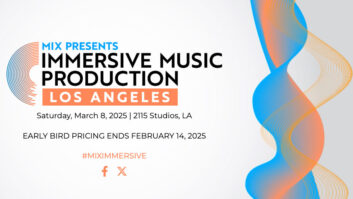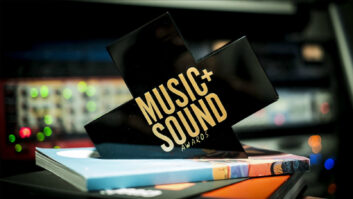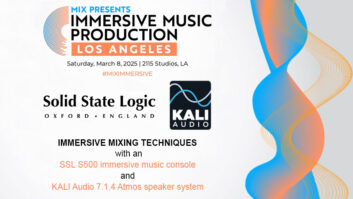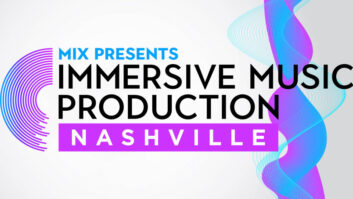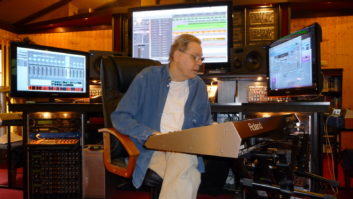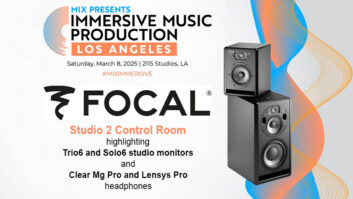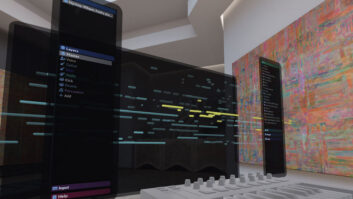With its new album Blue Field, The Luxembourg Signal takes its dreamy—and catchy—indiepop soundscapes to a new level of artistry. Comprised of seven members located on both sides of the Atlantic, the band’s new album is cohesive, fluid and well constructed. Pro Sound News recently caught up with a handful of the band’s members and talked about artistic continuity and economical recording, among other things.
On making the second album count:
Johnny [Joyner, guitar]: Like most bands, we wanted to try something different from what we did on the first record. Our first record came together pretty organically, as did the formation of the band—which basically formed from two bodies. Having two female vocalists to lead was great; on certain songs, Beth [Arzy, vocals] would sing really well, and then there were other songs that were more in Betsy’s [Moyer, vocals] range. Also, on this record, we ended up using a lot more synths than we’ve had in the past. Brian [Espinosa, drums] has some Moog synthesizers he has been playing around with that he has owned for ages. From a writing standpoint, I probably wrote the majority of the songs on the last record whereas this one was definitely more of a collaborative effort.
On working with Mark Rains:
Johnny: By this point, we had worked with various people. Mark was someone we felt we knew and who we felt could go in there and put all the pieces together. Also, he mixed the first record and we just enjoyed working with him. I think he got the sound we were going for. Another great thing was that he played drums before he was a recording engineer, so he really understands drum tones and is able to get really good drum sounds. This of course is among the harder things to do. Working with Mark also helped from a cost perspective as well—we would put the foundation of drums down with him and then just take it home where we could experiment with guitars and keyboards. The bad thing about this is that you can have a record that takes a couple of weeks, or half a year or more because you have endless time to work on it at home.
On nuances of drum recording:
Brian: Mark understands his room really well. He’s got a great mic locker, a great drum locker, and he definitely understood our sound. He would hear a song and I would be behind the kit all miked up. Then he would run out of the control room, switch out a snare drum or switch out a tom drum and the mic place right where he needs and then run back in the control room. He knows exactly what tone he wants to get out of that drum, and was able to curate some of these sounds based on the tone of the songs. And I really appreciated that. We placed the utmost trust in him and it was such a relief for us all that it turned out so great.
On click tracks:
Brian: Much of the orchestration ends up happening in our home studio. Not to give away our secret sauce, but I have always been a click track guy as a drummer so I am used to it. Working this way, we can put down a guitar riff or a keyboard part, and sometimes, those original guitar parts or original keyboard parts make the final cut. We might end up putting some EQ on it, but thank God we recorded them to a click track so it just fits in that song!
On value-driven equipment:
Brian: It is so nice to be able to get decent equipment at inexpensive prices now. A lot of our stuff is recorded on an RME Babyface Pro and it is such great quality. The converters are great, and so are the preamplifiers. All of the vocals on this album were recorded in our bedroom, and we tried several different mics on vocals. We ended up using a Neumann TLM 103 on Beth and an MXL V69 on Betsy. For Bobby’s [Wratten] vocals, we sent that particular track to Ian Catt in London and he recorded it.
On ‘Fall Feeling’:
Johnny: When I wrote the melody line to to that song, it just didn’t fit into the vocal range of either Beth or Betsy. It just happens every so often where the melody may be just out of their natural range. We were messing around with it, and then Beth said ‘Maybe Bobby will sing it.’ We all thought that was a pretty good idea, and he was up for it. When you have material getting tracked without you, you are eager to get it back. But we knew that Bobby and Ian worked together quite a bit so we were comfortable that it was going to come back sounding good. He track sent back to us and it sounded really great.
On artistic continuity:
Ginny [Pitchford, keyboards]: ‘Blue Field’ is a visual phenomenon that happens when you stare up at a bright blue sky and see funny dots and other things. So we thought that would make a great album title and that it could fit in with the artwork as well. We kind of wanted it to have a very bright visual—almost like station artwork along the lines of James Turrell, which features stark simplicity and brightness.
Brian: We used an artist named Michael Stickley who is an artist in Los Angeles. He does our covers and also did our 7-inch single for “Laura Palmer.” Our relationship with him as an artist is similar to our relationship to Mark who does our mixing: Unlike a lot of other artists out there, he understands what you want. It was almost like mixing an album—we would tell him what we wanted, then he would send us something back until we were all in love. The idea for the cover came from Ginny and our artist was able to translate those ideas.
